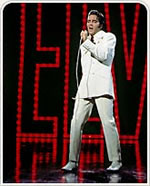February 1966
Elvis Presley records the soundtrack music and shoots his
twenty-second motion picture,
Spinout,
co-starring
Shelley Fabares.
March 1966
Frankie and Johnny opens nationally and doesn’t do
particularly well. The soundtrack album goes to number twenty.
June 1966
Paradise, Hawaiian Style
is released and doesn’t do well. The soundtrack album
peaks at number fifteen.
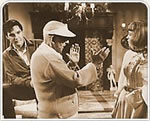
June-September 1966
Soundtrack recording and shooting for
Elvis’ twenty-third motion picture (to be the twenty-fourth
released),
Double Trouble.
September 1966
Soundtrack recording and filming for Elvis’ twenty-fourth motion
picture (the twenty-third to be released),
Easy Come,
Easy Go.
November 1966
Spinout opens nationally and doesn’t do well. The
soundtrack album goes to number 18.
December 1966
Elvis formally proposes marriage to Priscilla.
February 1967
Elvis buys a 163-acre ranch in Mississippi, minutes across the
Tennessee state line from Graceland. He and his entourage and
their wives had become interested in horseback riding after
Elvis purchased a horse for Priscilla as a gift. The hobby had
outgrown the pasture at Graceland. Over the months to come,
Elvis and the gang will enjoy spending a lot of time at the
Circle G. It becomes a happy diversion for Elvis as his
frustration and unhappiness over the state of his career reaches
its height.
March 1967
Easy Come, Easy Go opens nationally and doesn’t do well.
RCA releases Elvis’
second gospel album,
How Great
Thou Art, which was recorded in mid-1966. It gets
very good reviews and goes on to earn Elvis the Grammy Award for
Best Sacred Performance from the National Academy of Recording
Arts & Sciences. This is the first of his three Grammy wins.
February-April, 1967
Soundtrack recording and filming for
Clambake,
Elvis’ twenty-fifth movie. It is the third of three Elvis movies
to co-star
Shelley
Fabares.
April 1967
Double Trouble opens nationally. Although better than
some of his recent screen efforts, it doesn’t do well at the box
office.
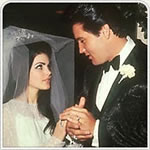
May 1967
On May 1, Elvis and Priscilla are married
in a private ceremony amongst a small group of family and
friends at the Aladdin Hotel in Las Vegas, just after 9:30 AM. A
press conference and breakfast reception follow. The couple
honeymoon for a few days in Palm Springs. Elvis wraps up some
over-dubbing on Clambake. Then they return to Memphis.
May 29, 1967
Elvis and Priscilla dress in their wedding clothes and have a
second wedding reception in the trophy room at Graceland to
accommodate family and friends who were not in Las Vegas for the
wedding.
June-July 1967
Soundtrack recording and filming for Elvis' twenty-sixth movie
(to be the twenty-seventh released),
Speedway,
co-starring
Nancy Sinatra. During the production, news of
Priscilla's pregnancy is announced.
September-November, 1967
Soundtrack recording and filming for Elvis' twenty-seventh movie
(to be the twenty-sixth released),
Stay Away, Joe.
In this western-themed comedy he once again plays a character
who is part Native American. It's a real departure from the
virtually interchangeable plots and characters in most of the
films over the past several grueling years. He has fun with this
one.
December 1967
Clambake is released nationally and goes to number
fifteen at the box office. The soundtrack album goes to number
40.
February 1, 1968
Priscilla gives birth to Lisa Marie Presley nine months to the
day after her marriage to Elvis. It is a time of great
happiness.
March 1968
Stay Away, Joe opens to mixed reviews and doesn't do well at the
box office, though like all of Elvis’ films, it makes a profit.
Soundtrack recording and filming for Elvis' twenty-eighth movie,
Live a Little, Love a Little. It is a sexy, more
adult kind of comedy/ melodrama. It,
like Stay Away, Joe is a real departure from the typical
Presley film. It is yet another breath of fresh air.
June 1968
Speedway is released nationally and doesn’t do very well.
The soundtrack album goes only as far up the chart as number 82.
Mid-to-Late June, 1968
Elvis rehearses for the taping of his first television special.
A press conference is held on June 25th. Videotaping is done
June 27, 28, 29, and 30. Commonly referred to as
The ‘68 Special or The ‘68 Comeback. the
actual name of this landmark television special is Elvis.
The sixties have brought about great change in music and pop
culture. Change for which Elvis helped pave the way over a
decade earlier when he exploded onto the scene with his unique
blending of pop, rock, country, R&B and gospel influences.
Focusing on his Hollywood movie career in the sixties, Elvis has
become less a part of the current pop cultural scene. He has
been making one movie after another, and many of the records he
has put out in these years have been movie soundtrack albums. In
the fifties and early sixties, the films and film-related
records were wonderfully successful, but as the sixties have
worn on, the movies and records, though still profitable, have
not been nearly so successful as they were before.
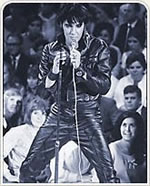
Elvis has reached the supreme level of frustration with the
state of his career and all its limitations on his creativity
and artistic expression. He had hoped to become a serious actor,
but Hollywood had other ideas and Elvis went along with them.
His opportunities to show his true talents as an actor have been
few. He is beyond ready for a change. By now, it has been more
than seven years since Elvis has appeared in front of a live
audience. Elvis has missed the closeness of his audience, the
energy and excitement of live performing.
The '68 Special opens with Elvis singing a hot new
version of the gutsy "Trouble", from his 1958 film King
Creole. This segues into Guitar Man, which, with its
semi-autobiographical lyrics, becomes the underlying theme of
the show. Then, Elvis is reunited with two of his original
fifties band members, guitarist
Scotty Moore and drummer
D.J. Fontana.
(Bass player
Bill Black
has been deceased for several years by this time.) They sit
together on stage in the round, along with several other friends
and associates of Elvis for an informal session of singing,
jamming, and swapping stories. Parts of this jam session are
woven throughout the show. There are also sequences of Elvis
taking the stage alone and performing many of his greatest hit
rockers and ballads, and he introduces a new song, Memories.
One can surmise that he pours out years of career frustration
and pent-up creative energy into the performance of these songs.
His natural talent, charisma, sensuality and stage presence have
not been diminished by the years in Hollywood. In fact, he
looks, sounds, moves and grooves better than he ever has. At 33,
he is better than he has ever been. Better than anybody in the
business. For the group jam session segments and solo stage
performances Elvis wears a two-piece black leather outfit
specially designed for the show by
Bill Belew, who also designed
all the other wardrobe Elvis and the cast wear in the show. The
look evokes the era of James Dean and the Marlon Brando type
motorcycle films of the fifties,
the era when Elvis was first proclaimed the King of Rock 'n'
Roll.
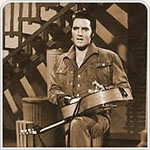
In one of the jam session segments, Elvis speaks of the gospel
origins of rock and roll. This segues into the gospel music
portion of the show, which has Elvis wearing a two-piece
burgundy suit, singing "Where Could I Go But to the Lord," "Up
Above My Head" and "I’m Saved," backed by the female vocal
group, The Blossoms, and accompanied by a troupe of dancers -
all of this for a rousing gospel production number.
Toward the end of the special Elvis appears in a lengthy
production number that, through song, dance, karate, and various
situations, traces a young man’s journey from a struggling
guitar player, through the challenges, dangers and compromises
on the path to his dreams of success and superstardom. Something
is lost along the way. Once the dream is achieved, the man
realizes that he remains unfulfilled, that he has abandoned his
true self. He decides to return to his roots, doing what made
him happiest, what he does best. He sings “I’ll never be more
than what I am... a swingin’ little guitar man.” The parallels
to Elvis' own life are clear and deliberate, and his doing the
‘68 special represents his own return to his true self, to his
roots. Free from the confines of his Hollywood grind, this is
Elvis the singer, the performer, the musician, the man - the
real Elvis.

